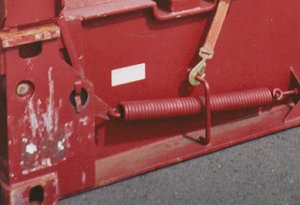The CTU guidelines provide very detailed instructions on what action is to be taken after packing has been completed. Special instructions are given for cargo transport units with dangerous cargoes. Section 4.4.2 deals with the documentation. This states:
4.4.2.1 For transport by sea, regulation 5 of chapter VII of SOLAS 1974, as amended, requires that the person responsible for the packing of dangerous cargoes into a container or road vehicle shall provide a signed Container Packing Certificate or Vehicle Declaration stating that the cargo in the unit has been properly packed and secured and that all applicable transport requirements are met.
| 4.4.2.2 The IMDG Code recommends the following declaration: |
| - |
The container/vehicle was clean, dry and apparently fit to receive the cargoes. |
| - |
If the consignments include cargoes of class 1 other than division 1.4, the vehicle or freight container is structurally serviceable in conformity with Section 12 of the introduction to class 1 of the IMDG code. |
| - |
No incompatible cargoes have been packed into the vehicle or freight container (unless authorized by the competent authority concerned in accordance with 12.2.1 or 17.6.3.1 of the General Introduction to the IMDG code). |
| - |
All packages have been externally inspected for damage, leakage or sifting, and only sound packages have been packed. |
| - |
All packages have been properly packed into the vehicle or freight container and secured. |
| - |
Drums have been stowed in an upright position, unless otherwise authorized by the competent authority. |
| - |
The vehicle or freight container and the packages therein are properly marked, labelled and placarded. |
| - |
The dangerous goods declaration required in subsection 9.4 of the General Introduction to the IMDG code has been received for each dangerous cargoes consignment packed in the vehicle or freight container. |
4.4.2.3 A Container Packing Certificate/Vehicle Declaration is not required under the RID, ADR, ADN or ADNR regimes, even though they may be required for inland domestic transport in certain countries. However, such certificates will be needed if the transport operation includes sea voyages. They will then need to be provided prior to loading, as port authorities, berth operators and shipmasters may wish to sight them (or a copy) before accepting containers or vehicles packed with dangerous cargoes into their premises or aboard their ship.
In accordance with Section 8 of the GGVSee, manufacturers and distributors have special duties. Usually, they are referred to as the "shippers".
4.2.2 The shipper should also ensure that dangerous cargoes are packaged, packed, marked, labelled, placarded and provided with the required signs, in accordance with the applicable regulations. A declaration that this has been carried out is normally required. Such a declaration may be incorporated into or attached to the transport documents.
4.4.2.5 The functions of the dangerous goods declaration (see 4.2.2) and of the Container Packing Certificate/Vehicle Declaration may be incorporated into a single document; if not, these documents should be attached one to the other. If these functions are incorporated into a single document, e.g. a Dangerous Goods Declaration, shipping note, etc., the inclusion of a phrase such as "it is declared that the packing of the cargoes into the container/vehicle has been carried out in accordance with the provisions of section 17 of the General Introduction to the IMDG code" is sufficient. Where both declarations are included in a single document, separate signatures are required for the two declarations.
 |
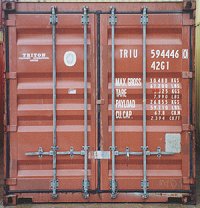 |
Container set down, closed
and sealed correctly |
3.3.3 After closing the doors, it should be ensured that all closures are properly engaged and secure. Usually a seal is applied to a container. Care should be taken that sealing procedures are carried out properly.
 |
 |
 |
| |
Correctly closed and sealed containers |
 |
 |
Correctly closed roof on an open-top container |
When using flatracks with a load covered with a tarpaulin, it must always be taken into consideration that the flats are transported on deck. The tarpaulins must therefore be secured against storms.
 |
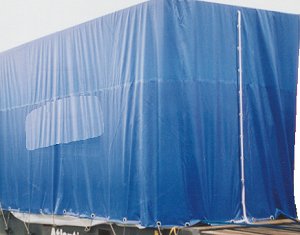 |
This tarpaulin would be torn in stormy weather. |
 |
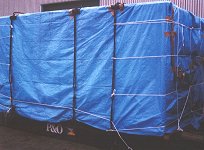 |
 |
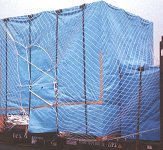 |
| |
Better but still not 100% |
|
Tarpaulin secured
against storms |
3.3.4 Where CTUs have hinged or detachable fittings, a check should be made that they are properly secured, with no loose equipment likely to cause a hazard during transport.
A check should additionally be performed on refrigerated containers to ensure that the correct refrigeration temperature has been set. Containers carrying dangerous cargoes must be provided with the relevant placards. For further information, see the sections on refrigerated containers and marking of containers with dangerous cargoes.
If a container is shipped to a country in which there are quarantine regulations regarding the treatment of wood, e.g. Australia, New Zealand and China, it must be ensured that all wood carried in the container conforms to these regulations. Either all parts must have previously been fumigated or heat-treated and marked appropriately, or the entire container must be subjected to special treatment. A copy of the wood treatment certificate must always accompany the container. This should be stored directly inside the right-hand container door or in a weather-resistant pouch on the outside of the door.
|
 |
 |
| |
Notice on a plywood case |
Fumigation stamp
on a wooden wedge |
|







